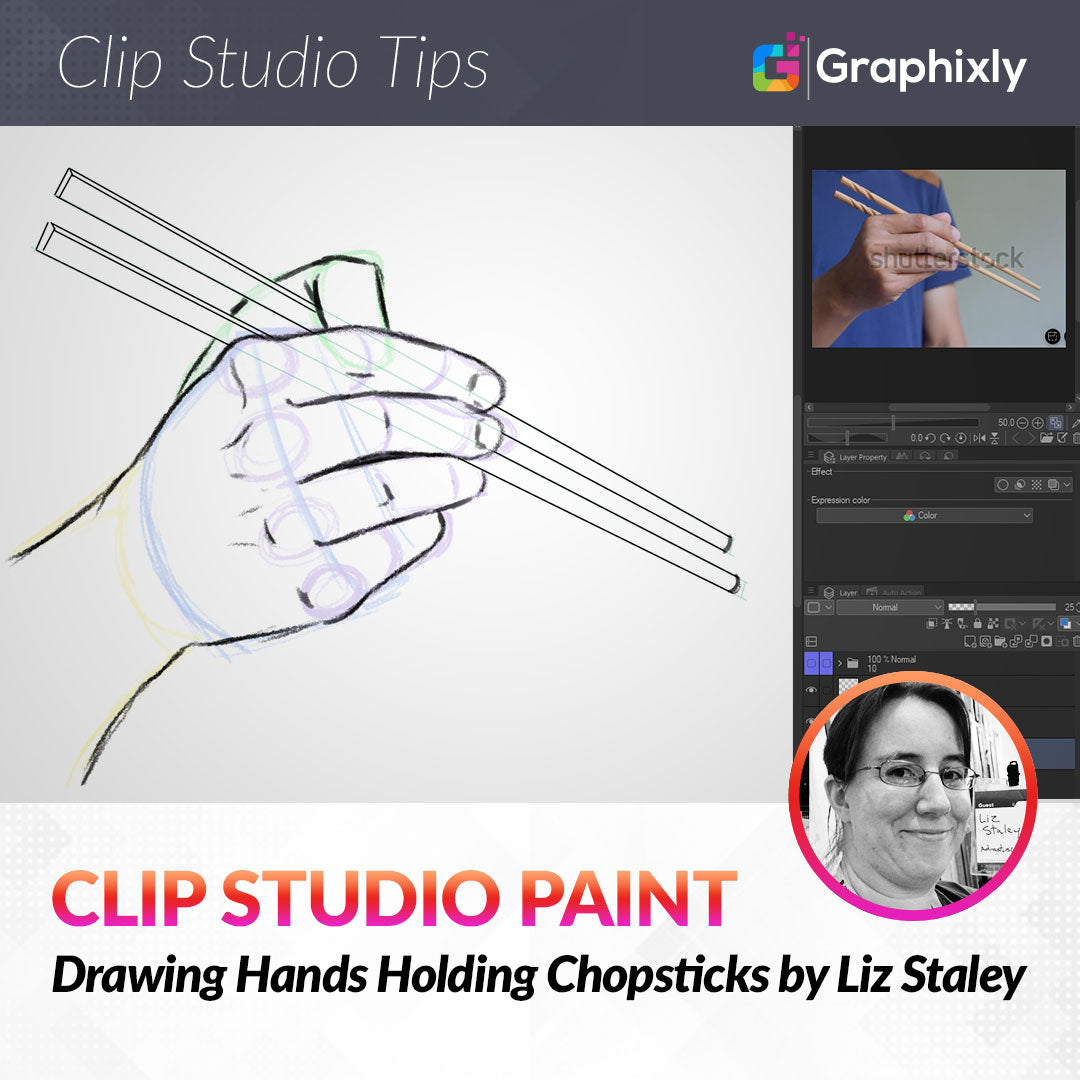
Drawing Hands Holding Chopsticks
Contact Graphixly @
Hello! My name is Liz Staley and I’m a long-time user of Clip Studio Paint (I started using the program back when it was known as Manga Studio 4!). I was a beta-tester on the Manga Studio 5 program and for Clip Studio Paint, and I have written three books and several video courses about the program. Many of you probably know my name from those books, in fact. I write weekly posts on Graphixly.com and on CSP Tips, so be sure to come back every week to learn more Clip Studio Tips and Tricks from me!
Hands holding chopsticks are something you’re very likely to see in manga. But they can be a challenge to draw. So let’s break down a pose of hands drawing chopsticks to see how it all goes together!
Let’s get drawing!
Drawing the Hand
It is very important when drawing something you’re unsure of to have reference images. Thankfully, a picture of a hand holding chopsticks is very easy to find online! There are tons of results to look at on Google Images from all sorts of angles. For easy access to your reference, you can load it to the Subview window. If you don’t know about the Subview window, you can learn more in this previous article from me: https://tips.clip-studio.com/en-us/articles/3139#15f2b74e

In addition to some photo reference, I will also be looking off of a pose from CSP User Seagullll, who created an awesome pack of vector hands holding chopsticks that are available to use. However, since the asset pack does cost 50 gold at the time of this writing, I will not be showing the full pose that I picked in this article. However, if you do get this asset pack, I am working from Pose 10 (which you can see in the layer palette in the screenshot above)
Here is a link to the asset pack https://assets.clip-studio.com/en-us/detail?id=1869213
The first thing I like to do when drawing hands interacting with any object is to rough in the shape of the object. This helps me position the hand and fingers around the object instead of drawing the hand and then trying to fit the object in later. So, using the straight line Direct Draw tool, I made two long, thin, slightly tapered rectangles to represent my chopsticks.

Next, I draw in the rough shape of the palm. This palm is a bit of a curved rectangle shape. Be sure to think about the form of the hand as well, because the palm is not a flat object!

Next up I will sketch the thumb. Here is where having multiple references comes in handy, because I actually liked the thumb better in the CSP Asset reference when compared to the photo reference. In the drawing reference the thumb wraps around the top chopstick a bit more and I liked that.

Now it’s time to start on the fingers. I wanted to be sure that I got the spacing of the fingers correct, so the first thing I wanted to do was mark out the knuckles where the fingers meet the palm. To do this I drew four ovals along the top of the palm.

Paying special attention to where the joints of the finger are, sketch in the rough shape of the top finger. Be sure to look at the distance between the end of the chopsticks and the end of the finger to get the size correct. Looking at the space between objects in your reference can help with the proportions in your drawings.

Now we can sketch in the rest of the fingers. The middle finger rests on top of the bottom chopstick, while the ring finger curves in slightly below it. The pinkie tends to tuck under the ring finger and the end joint of it may not be visible depending on how the hand is being held.

Finally, sketch in the position of the arm.

Once I’m happy with my rough sketch, it’s time to clean it up. The first thing I did was create a new layer and, using the straight line tool, made a slightly more detailed drawing of the chopsticks.

Now, make another new layer above the cleaned up chopsticks layer. This is to make the unnecessary parts of the chopsticks easier to erase once the cleaned up sketch is done. On this new, empty layer, I took one of my favorite pencil tools and made a cleaner sketch with added details. If you want to add lines for knuckles and fingernails, it’s important to look at photo references when starting out so you understand where those lines go and how they will look.

Conclusion
This is how I would break down this hand pose. It is not the only way to do it, of course! But I know that I learn a lot from seeing how other artists do things so I hope that this will help someone else out there who wants to improve their hand drawings. Happy drawing!
For more information on CLIP Studio Paint, please visit https://www.clipstudio.net/en or https://graphixly.com